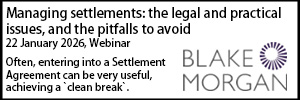Workplace investigations demystified
- Details
Jenny Arrowsmith and Jake Marshall set out ten lessons from the tribunals when it comes to the conduct of workplace investigations.
We are seeing an increased demand for guidance and training on how managers should conduct investigations in the context of grievances and disciplinary proceedings. Here’s a reminder of the key principles.
1. The more serious the allegation, the more thorough the investigation needs to be
In the case of A v B Mr A, a social worker, was dismissed for having an inappropriate relationship with a 14-year-old in his care. The dismissal was found to be procedurally unfair in light of the seriousness of the allegations as:
- There had been unacceptable delay in the investigation, reducing the reliability of witness evidence
- The investigator did not speak to all of the workers in the care home, partly because he believed that because of delays no-one would be able to recall events that had allegedly taken place more than 12 months ago; and
- The investigator relied on witness statements that had not been shared with Mr A
Investigators should also look for advice that supports the allegations as well as evidence that doesn't.
2. Only suspend if it is absolutely necessary
In Agoreyo v Lambeth, Ms A was a teacher who was suspended after it was alleged that she had used excessive force against three children in her class. She resigned and the Court of Appeal found that suspending her was a "knee jerk" reaction unsupported by evidence. This damaged the implied duty of trust and confidence between the parties and led to her constructive dismissal.
Employers need a reasonable and proper cause before suspending and even if suspending someone is justified, you should only suspend them for as short a time as possible to allow the investigation to go ahead.
You can read more about that case here.
3. Small businesses aren’t excused from proper investigations
In the case of Henderson v Granville Tours, a customer of a coach tour wrote a detailed letter of complaint about Mr Henderson’s driving. Granville Tours accepted the letter at face value and dismissed Mr Henderson. This was unfair, as the employer had made no attempt to check the complainant’s account with other witnesses or to test her veracity as a witness by interviewing her in person. The Employment Appeal Tribunal noted that the small size of the company did not excuse Granville Tours from investigating a customer’s complaint properly.
4. Take care when anonymising witness evidence
The ACAS guide to workplace investigations gives an example of employees who wish to remain anonymous when reporting theft by their colleague. It suggests that employers:
- Check if there is other compelling evidence (e.g. CCTV) that reduces the need for witness evidence
- Investigate the reasons for employees (or other witnesses) wanting to remain anonymous; consider if there is reason for them to fabricate their evidence
- Start by conducting interviews without anonymising any information. The investigator can then consider what to omit or redact to prevent identification
5. Be aware of unconscious bias
In the case of Sargeant v London Underground a male and a female employee had a confrontation in which they both used aggressive language and had to be separated by a colleague. They both lodged grievances and the same investigation officer investigated both. The grievance was made out against both, but due to the investigation findings, only the female employee was suspended and ultimately given a more serious sanction. The Tribunal found that the investigator’s sexist views of gender roles in the workplace skewed the investigation, lending inappropriate weight to evidence favouring the male employee.
6. HR must not influence the investigation
In Ramphal v Department for Transport, the investigator’s draft report found no evidence of dishonesty. After it came back from HR, the report identified dishonesty and recommended that the employee be dismissed without notice. The EAT found that HR had improperly influenced the investigation and advised that HR should not go beyond discussing issues of procedure and law.
7. Employers can’t refuse an eligible choice of companion
Where an employee is entitled to be accompanied at a disciplinary or grievance meeting, Toal v GB Oils Ltd made it clear that an employer cannot reject their choice, so long as they are either a trade union official employed by the union, certified as competent by a union or another of the employee’s workers. This is the case even if the companion in question has a history of being disruptive. We recommend you seek specific advice if you are in this position.
8. Don't use an employee’s behaviour during the disciplinary process as evidence against them
In the recent case of Muir v Astra Zeneca UK Ltd, the tribunal criticised the employer’s reliance on the employee’s behaviour during the disciplinary process, stating:
“it should be appreciated that disciplinary hearings where an employee’s job is at risk can be incredibly stressful. Given what is at stake, some allowance should be made to take into account the impact that this might have on how an employee reacts and great care should be exercised in seeking to use that behaviour as evidence supporting allegations relating to earlier matters where objectively, the same jeopardy did not arise."
You can read our full analysis of this case here.
9. You may be able to fix issues with the original investigation in the appeal
In Khan v Stripestar Ltd, an employee was dismissed after buying a car from a customer and authorising repairs on the vehicle in the garage he worked at without disclosing he was the new owner. The disciplinary hearing held by the employee’s manager lasted six minutes. The employee appealed and the second manager carried out a thorough investigation, upholding the outcome of gross misconduct dismissal. The tribunal found that although the original disciplinary process was clearly unfair, this had been remedied by the thorough investigation on appeal.
10. Legal privilege is not as broad as you might think
In University of Dundee v Chakraborty, an investigator submitted her investigation report to the university, who then obtained legal advice on it. The university then disclosed an amended version to Mr Chakraborty, stating in the footnotes that it had been “amended and reissued following independent legal advice.” The tribunal ordered disclosure of the original report, even though that might give a clue as to the content of that legal advice. This was upheld by the Inner House of the Scottish Court of Session. The original version of the report wasn’t privileged when it was sent to the university and it did not retrospectively gain privilege as a result of the legal advice.
The following situations are also unlikely to be covered by legal professional privilege:
- Communications within your organisation (such as within HR)
- If you send advice that you have received from your lawyers to someone in your organisation who are not instructed to give or receive legal advice
- If you send advice you have received from your lawyers (and any other related documents) to a third party outside of your organisation such as to an OH advisor, or another type of expert
- You instruct experts that are not covered by legal advice privilege
There are other types of privilege that may apply including: litigation privilege and without prejudice. This is a complex area and we recommend that you take advice before preparing documents that you would not want to be disclosed in a tribunal.
Jenny Arrowsmith is a partner and Jake Marshall is a Trainee Solicitor at Irwin Mitchell.











